Volcano X: In-depth Analysis of Trends After Bitcoin Halving
As the fourth Bitcoin halving approaches, the cryptocurrency market is expected to experience a critical moment. This event is anticipated to occur between April 16 and 20 this year, with Bitcoin miner rewards being halved from 6.25 BTC per block to 3.125 BTC. While historical halvings have been key indicators of potential market trends, Volcano X urges caution when directly inferring past patterns to predict future outcomes due to the limited sample size of the previous three events.
A New Era of Bitcoin Market Dynamics
The launch of spot Bitcoin ETFs in the United States has fundamentally changed the supply and demand dynamics of Bitcoin. Within two months of their establishment, these ETFs have seen net inflows of billions of dollars, marking a significant shift in market dynamics. This development not only establishes a new benchmark for BTC demand but also suggests that the upcoming halving may have a unique impact on the market, differing from previous cycles. Given these changes, understanding the current technical supply and demand situation is crucial for grasping the potential scenarios post-Bitcoin halving.
Supply Constraints and Market Capacity
While the reduction in new Bitcoin supply is a key factor to consider, it is just one of many factors influencing cryptocurrency value. Since the beginning of 2020, the supply of Bitcoin available for trading (i.e., the difference between circulating and non-circulating supply) has been declining, indicating a significant change compared to previous cycles. However, recent data shows that since the beginning of the fourth quarter of 2023, the active BTC supply (Bitcoin that has moved in the past three months) has increased by 1.3 million, while newly mined Bitcoin has only increased by about 150,000. Although the market's capacity to absorb this supply has improved, Volcano X advises against oversimplifying the complex interactions of market dynamics.
Background and Future Outlook
Bitcoin undergoes halving approximately every four years or every 210,000 blocks, effectively reducing miner rewards and thus decreasing the daily issuance of new Bitcoin. Post-halving, Bitcoin's daily output is expected to drop from around 900 to 450, with the annual inflation rate adjusted from 1.8% to 0.9%. These adjustments bring Bitcoin's monthly output to about 13,500 and an annual output of approximately 164,250, although these figures will be affected by changes in actual hash rates.
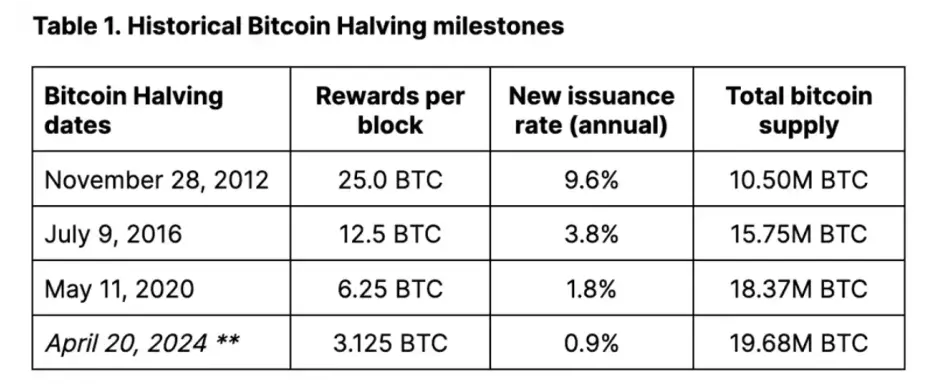
The halving mechanism embedded in the Bitcoin protocol will continue until all 21 million Bitcoins are mined, an event expected to occur around 2140. Volcano X believes the potential significance of halving lies not only in its direct market impact but also in its ability to attract significant media attention to Bitcoin's unique attributes: a fixed, deflationary supply schedule that ultimately leads to a hard cap on supply. This aspect of Bitcoin is often underestimated.
For tangible commodities like minerals, additional resources can theoretically be invested to mine and extract more resources, such as gold or copper. Although entry barriers may be high, price increases can incentivize meeting demand. However, due to Bitcoin's preset block rewards and difficulty adjustment mechanisms, its supply remains inelastic (i.e., unresponsive to price changes). Furthermore, Bitcoin encapsulates a growth narrative. The utility of the Bitcoin network expands with the number of users on the network, directly impacting the value of the token. This sharply contrasts with precious metals like gold, which do not have a similar growth expectation.
History Does Not Repeat Itself, But…
Our analysis of Bitcoin's performance during halving cycles is inherently limited, as only three have occurred previously. Therefore, studies on the correlation between past halvings and Bitcoin prices should be approached with caution; the small sample size makes it challenging to pattern these events based solely on historical analysis. In fact, we believe more halving cycles are needed to draw strong conclusions about how Bitcoin "typically" reacts to halving. Additionally, correlation does not imply causation, as factors including market sentiment, adoption trends, and macroeconomic conditions may all contribute to price fluctuations.
Indeed, our previous hypothesis is that Bitcoin's performance in halving events depends on context, which can explain the significant variations in price trajectories across different cycles. As shown in Figure 1, Bitcoin's price remained relatively stable in the 60 days leading up to the first halving in November 2012, while in the same time frames before the second and third halvings in July 2016 and May 2020, Bitcoin's price increased by approximately 45% and 73%, respectively. This variability highlights the complex interactions between factors influencing Bitcoin's price, indicating that each halving cycle unfolds within its unique contextual framework.
In our analysis, the beneficial effects of the first halving did not fully materialize until January 2013, when the impact of the Federal Reserve's quantitative easing program (QE3) intertwined with concerns over the U.S. debt ceiling crisis. Therefore, we believe that amid widespread inflation concerns, increased media coverage of the halving can enhance public awareness of Bitcoin as an alternative store of value. In contrast, in 2016, Brexit may have triggered financial anxiety in the UK and Europe, potentially catalyzing Bitcoin purchases. This trend continued into the ICO boom of 2017. In early 2020, unprecedented stimulus measures taken by central banks and governments in response to the COVID-19 pandemic once again significantly boosted Bitcoin's liquidity.
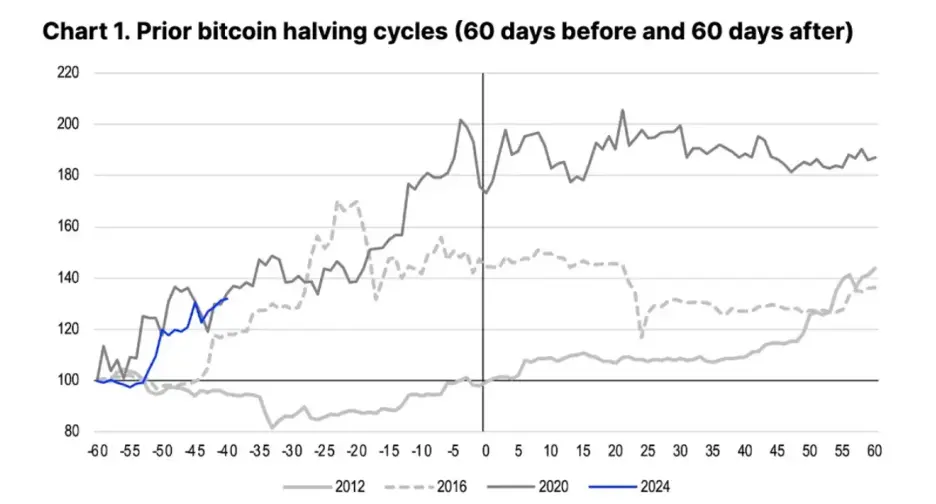
It is also important to note that analyses of historical performance may vary significantly depending on the observation period relative to halving events. Whether the analysis focuses on 30, 60, 90, or 120 days post-halving, price return metrics may differ. Therefore, employing different windows may affect the conclusions drawn from past price performance. For our purposes, we use a 60-day timeframe as it helps filter out short-term noise while remaining close enough to the halving for other market factors to potentially begin dominating price drivers in the long term.
ETFs: The Key to Success
The launch of spot Bitcoin ETFs in the U.S. is reshaping Bitcoin's market dynamics by establishing a new benchmark for Bitcoin demand. In previous cycles, liquidity was a key barrier to price momentum, as major market participants (including but not limited to Bitcoin miners) would push for sell-offs in an attempt to exit long positions. The emergence of spot Bitcoin ETFs fundamentally alters this dynamic, providing a more structured and accessible way for institutional and retail investors to engage with Bitcoin.
By acting as a bridge between traditional finance and the cryptocurrency world, these ETFs alleviate some of the liquidity issues previously observed and broaden the investor base. This diversification of market participation not only enhances liquidity but also has the potential to stabilize price volatility associated with large-scale sell-offs. Moreover, the institutional support implied by ETF issuance lends a degree of legitimacy to Bitcoin, encouraging further adoption.
In summary, the continuously evolving environment marked by macroeconomic factors, emerging investment tools like ETFs, and shifts in market sentiment plays a crucial role in shaping Bitcoin's journey post-halving. While history provides valuable insights, the unique conditions surrounding each halving event converge to mean that future outcomes cannot be predicted solely based on past trends. Therefore, stakeholders should combine historical knowledge with a focus on current developments to approach the market.
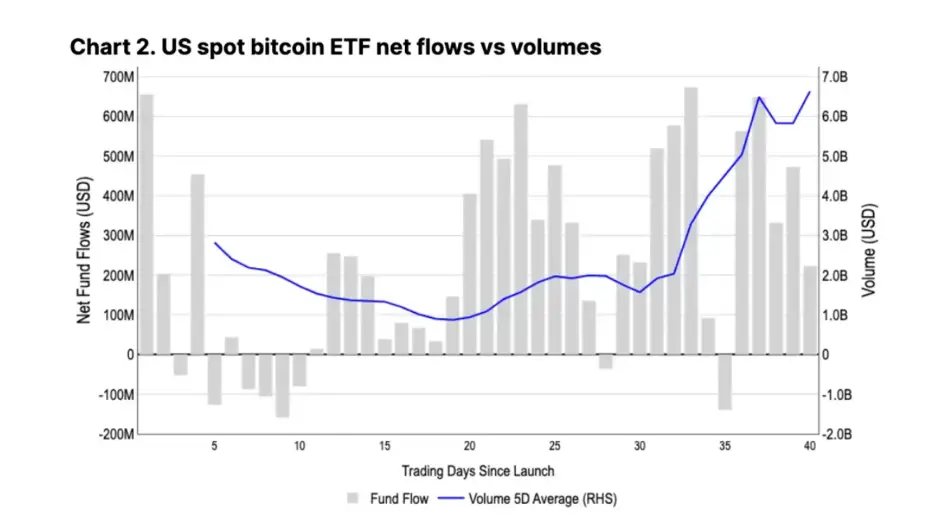
Today, the inflow of funds into ETFs is expected to absorb a significant portion of the supply in a gradual and sustained manner. Currently, the average daily trading volume of BTC in ETFs is estimated to be between $400 million and $5 billion, accounting for 15-20% of the total trading volume on global centralized exchanges. This level of liquidity is sufficient for institutions to execute trades easily within this space. In the long run, this stable demand could positively impact Bitcoin's price, as it may foster a more balanced market and reduce volatility associated with concentrated sell-offs.
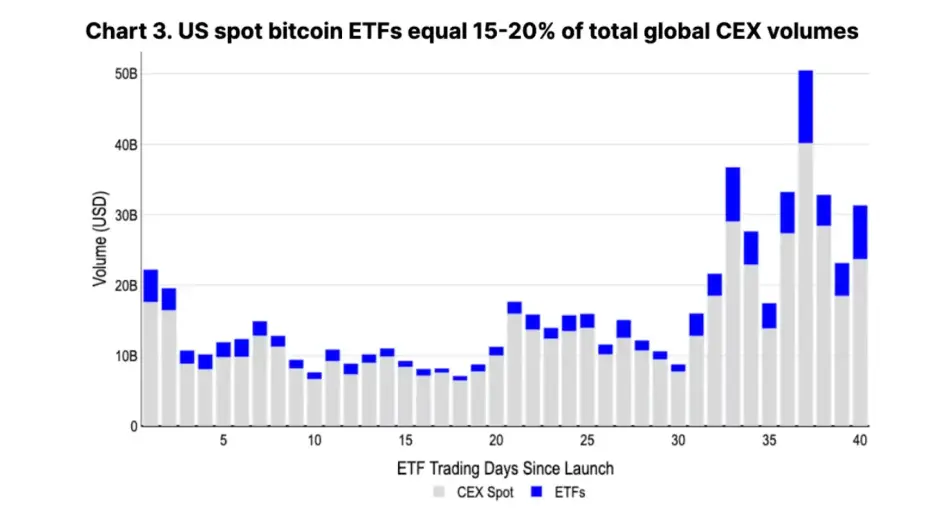 In the first two months post-launch, U.S. spot Bitcoin ETFs attracted $9.6 billion in net inflows, bringing total assets under management to $55 billion. This development indicates that during this period, these ETFs (holding 180,000 coins) have accumulated net growth of BTC nearly three times the 55,000 new Bitcoin supply produced by miners (as shown in Figure 3). According to Bloomberg, the total amount held by all spot Bitcoin ETFs globally currently stands at approximately 1.1 million Bitcoins, accounting for 5.8% of the total circulating supply.
In the first two months post-launch, U.S. spot Bitcoin ETFs attracted $9.6 billion in net inflows, bringing total assets under management to $55 billion. This development indicates that during this period, these ETFs (holding 180,000 coins) have accumulated net growth of BTC nearly three times the 55,000 new Bitcoin supply produced by miners (as shown in Figure 3). According to Bloomberg, the total amount held by all spot Bitcoin ETFs globally currently stands at approximately 1.1 million Bitcoins, accounting for 5.8% of the total circulating supply.
In the medium term, we may see ETFs maintain or even increase their current liquidity levels, as major brokerage firms have yet to begin offering these products to clients. With over $6 trillion still in U.S. money market funds and expectations of imminent interest rate cuts, we believe a significant amount of idle capital will flow into this asset class within the year.
It is worth noting that potential concerns regarding the concentration of Bitcoin holdings due to ETFs do not pose a stability risk to the network, as merely holding Bitcoin does not affect the decentralized network or allow control over its nodes. Furthermore, financial institutions currently cannot offer derivatives based on these ETFs as underlying assets. The availability of such derivatives could change the market structure for large participants. However, conservatively, regulatory approval for these derivatives may still take months.
This development underscores a significant shift in institutional participation in the cryptocurrency space, driven in part by the tools of ETFs. As the situation evolves, the integration of traditional financial products with digital assets like Bitcoin not only expands accessibility but also introduces new dynamics in market liquidity, investor base expansion, and potential mitigation of price volatility. Continuously adjusting the regulatory framework to accommodate these innovations is crucial for shaping Bitcoin's future trajectory and its integration into the broader financial ecosystem.
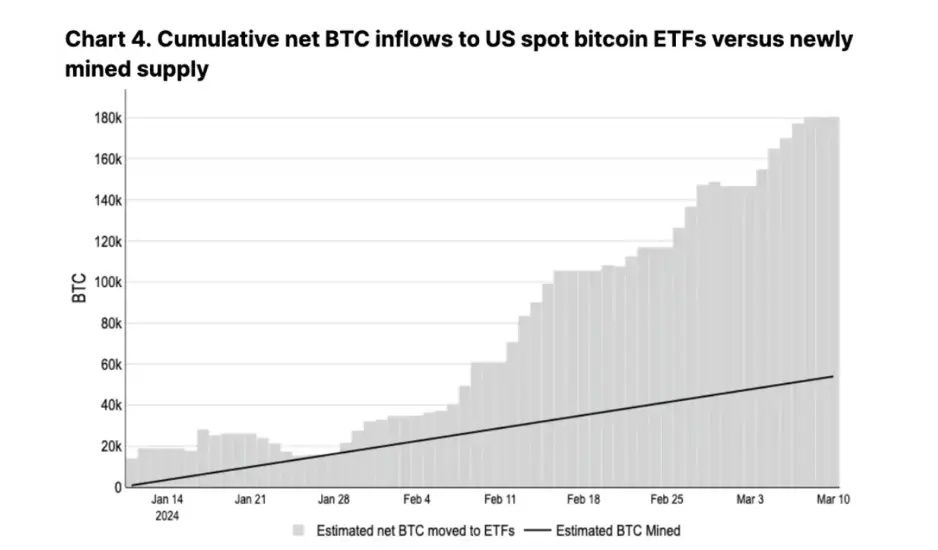
Assuming the pace of new capital inflows into U.S. ETFs slows from $6 billion in February to a steady state of $1 billion in net inflows per month, a basic mental model suggests that Bitcoin's average price should be around $74,000 relative to the approximately 13,500 BTC mined monthly post-halving. However, a significant limitation of this model is the assumption that miners are the only source of Bitcoin supply in the market. In reality, the imbalance between newly mined Bitcoin and ETF inflows represents only a small part of the long-term cyclical supply trend.
Lies, Damned Lies, and Statistics
One way to measure the available trading supply of Bitcoin is to subtract (1) the current circulating supply (19.65 million BTC) from (2) the illiquid supply, which includes Bitcoin that has essentially stopped circulating due to wallet loss, long-term holding, or being otherwise locked up. According to Glassnode, which classifies illiquid supply based on cumulative inflows and outflows over the lifecycle of entities, the available Bitcoin supply has been on a downward trend over the past four years, decreasing from a peak of 5.3 million BTC in early 2020 to the current 4.6 million. This marks a significant shift compared to the steady growth of available supply observed before and after the previous three halvings (as shown in Figure 5).
In the context of increasing institutional interest, the reduction in liquid supply, particularly through ETFs, highlights a fundamental shift toward a market state with lower liquidity. As illiquid supply increases—whether through long-term holding strategies, loss of access, or institutional acquisition—the available supply of Bitcoin contracts, potentially exerting upward pressure on prices in the face of stable or increasing demand.
This dynamic underscores the complex interplay between supply and demand factors influencing Bitcoin's price. While miners do add new Bitcoin to the ecosystem, the broader context includes changes in liquidity versus illiquid supply, institutional adoption rates, and macroeconomic trends. All these factors contribute to shaping the market environment for cryptocurrencies, complicating simple price prediction models based solely on supply-side considerations.
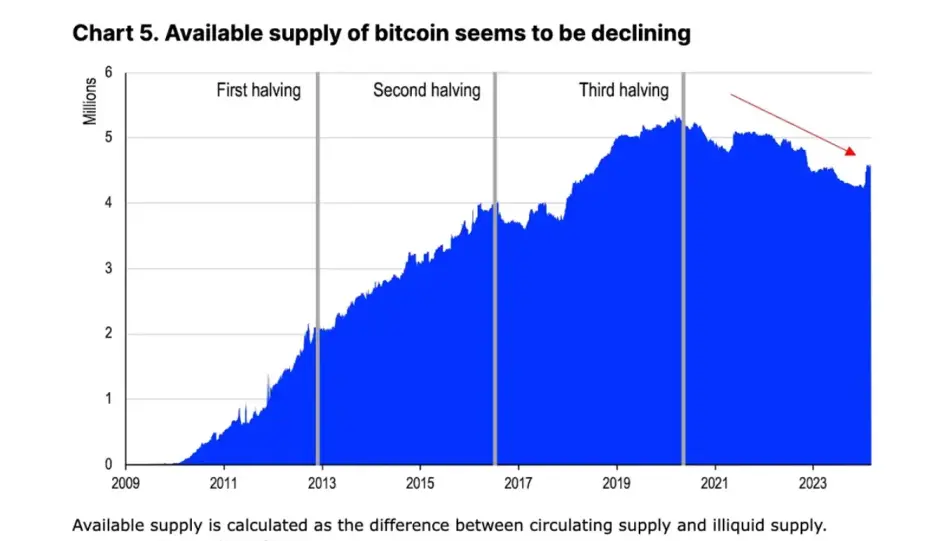
At first glance, the decline in Bitcoin's trading availability due to new institutional demand from ETFs seems to be one of the main technical supports for Bitcoin's performance. However, considering that new Bitcoin entering circulation is about to decrease, these supply-demand dynamics suggest potential short-term market tightening. That said, we believe this framework does not fully capture the complexity of Bitcoin market liquidity dynamics, particularly because "illiquid supply" does not equate to static supply.
Investors Should Not Overlook Several Key Factors That May Affect Sell Pressure:
- Not all Bitcoins that occupy the liquidity gap are "trapped." Long-term holders (holding Bitcoin for over 155 days, accounting for 83.5% of holdings) may be less sensitive to the economic aspects of their positions compared to short-term holders. However, we expect that as prices rise, some in this group may still choose to realize profits.
- Some holders may not intend to sell in the near future but can still provide liquidity by using their Bitcoin as collateral. This also somewhat affects the "illiquid" characteristics of these Bitcoins.
- Miners may sell their Bitcoin reserves (currently totaling 1.8 million BTC among public and private miners) to expand their operations or cover other costs.
- The approximately 3 million BTC held by short-term holders is not insignificant. In price fluctuations, speculators may still exit to take profits.
- Ignoring these important supply sources oversimplifies the argument that inevitable scarcity arises from reduced mining rewards and stable ETF demand. We believe a more comprehensive assessment is needed to determine the true supply-demand dynamics behind the upcoming halving event.
Active Supply and Flow
Even with Bitcoin incorporated into ETFs, the growth rate of active circulating supply (defined as Bitcoin transferred in the past three months) has significantly outpaced the cumulative inflow rate of ETFs (as shown in Figure 6). Since the fourth quarter of 2023, the active BTC supply has increased by 1.3 million, while newly mined Bitcoin accounted for only about 150,000.
The increase in active supply indicates that despite Bitcoin being absorbed into ETFs and other long-term holding strategies, a substantial amount of Bitcoin remains liquid and is part of active trading cycles. The dynamic nature of Bitcoin liquidity underscores the need for a nuanced understanding of the supply side of the market and how various factors (from miner behavior to investor sentiment) influence the overall liquidity landscape.
Additionally, influenced by macroeconomic factors, technological advancements, and regulatory changes, the ongoing fluctuations in Bitcoin liquidity will continue to affect its market dynamics. Therefore, stakeholders must remain vigilant and adjust their strategies to respond to expected and unforeseen changes within this complex ecosystem.
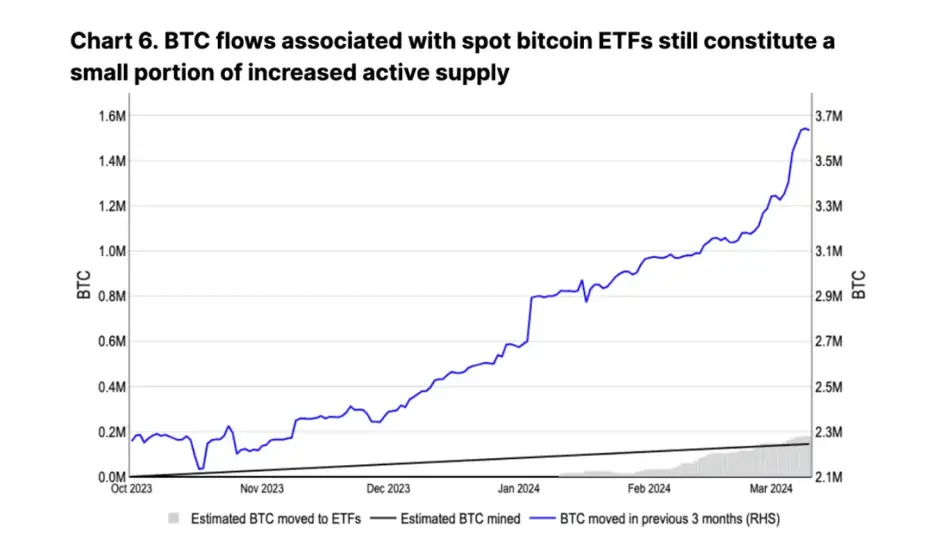
A portion of the active supply indeed comes from miners themselves, who may sell reserves to capitalize on price trends and build liquidity in the face of declining revenues—this was discussed in greater detail in our report "Bitcoin Halving and Miner Economics" published on January 30. This practice by miners reflects their behavior in previous cycles. However, Glassnode reports that between October 1, 2023, and March 11, 2024, miners' net wallet balance decreased by only 20,471 Bitcoins, indicating that the new active Bitcoin supply primarily comes from sources outside of miners.
In previous cycles, changes in active supply exceeded the growth rate of newly mined Bitcoin by more than five times. During the 2017 and 2021 cycles, active supply nearly doubled, increasing by 3.2 million (from a low of 6.1 million) over 11 months and by 2.3 million (from 3.1 million to 5.4 million) over 7 months, respectively. In contrast, the amount of Bitcoin mined during the same periods was approximately 600,000 and 200,000.
At the same time, in this cycle, Bitcoin's inactive supply (defined as Bitcoin that has remained unchanged for over a year) has also decreased for three consecutive months, which may indicate that long-term holders are beginning to sell (as shown in Figure 7). Normally, this would be interpreted as a mid-cycle signal. In the 2017 and 2021 cycles, the time span from the peak of inactive supply to the cycle's highest price was approximately 12 months and 13 months, respectively. The peak of inactive Bitcoin in the current cycle seems to have occurred in December 2023.
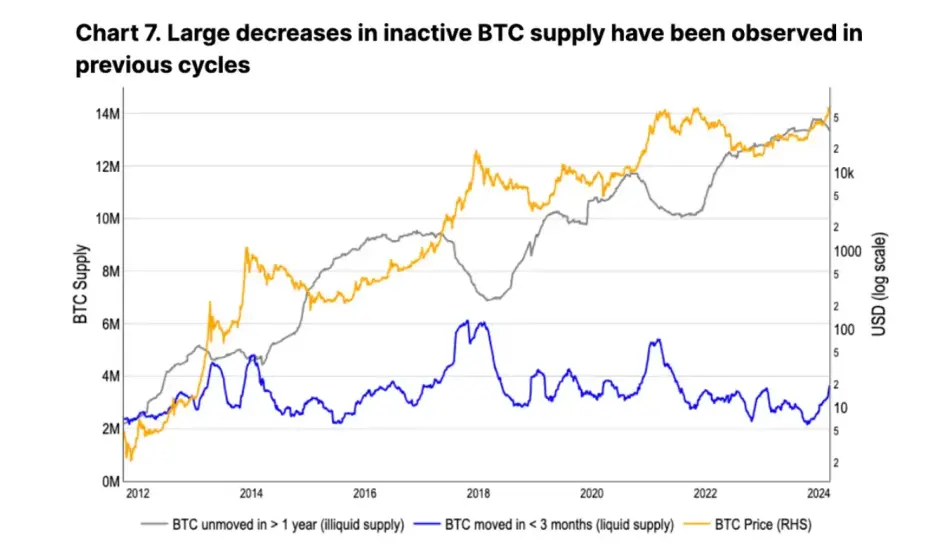
The market activity of long-term holders and miners, combined with the dynamic influx of institutional demand through ETFs, highlights the multifaceted nature of the Bitcoin supply-demand equation. The interaction between active and inactive supply provides valuable insights into market sentiment and potential future price movements.
Given these observations, stakeholders in the Bitcoin ecosystem should closely monitor these supply dynamics, as they can provide early signals of changes in market direction. Furthermore, understanding the behavior of different market participants (including miners, long-term holders, and institutional investors) aids in making informed decisions in this complex and ever-changing environment.
Conclusion
As we analyze the evolving landscape of Bitcoin and its integration with mainstream financial instruments at Volcano X, it is clear that this cycle offers unique dynamics compared to previous ones. The introduction of U.S. spot Bitcoin ETFs and the ongoing daily net inflows represent a significant driving force, marking a notable shift in institutional acceptance and investment in digital assets.
Considering the impending reduction in new Bitcoin supply due to the halving event, we observe a tightening of market dynamics that may alter the traditional supply-demand balance. While some may speculate on an impending supply crunch, our analysis indicates that future demand and sell pressure will need to find a new equilibrium.
The role of spot Bitcoin ETFs cannot be overstated. As a new asset class, these ETFs bridge the gap between traditional investment strategies and the realm of digital assets, marking a critical moment for Bitcoin's mainstream adoption. This development not only enhances the liquidity and stability of Bitcoin as an investable asset but also opens avenues for traditional investors to participate in the cryptocurrency market within a regulated framework.
Moreover, our research shows that the narrative surrounding Bitcoin's liquidity and supply dynamics is far more complex than it appears at first glance. The interplay between dormant supply becoming active, miner behavior, and the impact of derivatives amplifying spot market activity underscores the multifaceted nature of the Bitcoin market ecosystem.
In light of these insights, Volcano X maintains a cautiously optimistic outlook on Bitcoin's future. We assert that while there are direct obstacles related to supply and demand, the fundamental shifts occurring—primarily through the institutionalization of Bitcoin via ETFs—signal a promising trajectory for its long-term development. Therefore, we believe the current trends indicate that a potentially prolonged bull market phase may just be beginning, necessitating ongoing adjustments in market dynamics to foster a sustainable balance between supply and demand.
Disclaimer: This document is for informational and communication purposes only and does not constitute investment advice.
Image Sources:
https://www.deltecbank.com/










